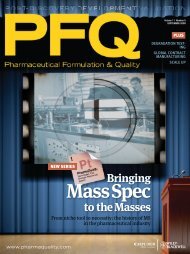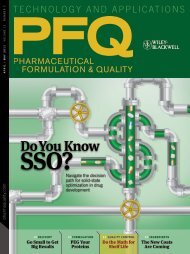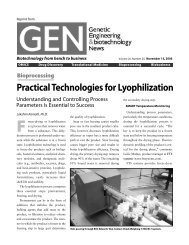Moving from Vials to Prefilled Syringes - Sterile Parenteral Drug ...
Moving from Vials to Prefilled Syringes - Sterile Parenteral Drug ...
Moving from Vials to Prefilled Syringes - Sterile Parenteral Drug ...
Create successful ePaper yourself
Turn your PDF publications into a flip-book with our unique Google optimized e-Paper software.
Table III: Filing requirements for prefilled syringes.Attribute*Container–closureMove <strong>from</strong> liquid vialMove <strong>from</strong>lyophilized vialSimilar? Refer <strong>to</strong> previous extractableand leachable studies <strong>to</strong> impart lubricity.Siliconization may be needed.Formulation No change. Change <strong>from</strong>freeze-dried powder<strong>to</strong> liquid.S<strong>to</strong>rageconditionsNo change.A stability study thatcollects 3 months ofcomparative accelerateddata and long-term dataof at least 1 batch (3 maybe required).A clinical study isrequired if degradationor impurities profileschange.May change.A stability study thatcollects 3 monthsof comparativeaccelerated andlong-term data on 3batches.A clinical study isrequired if degradationor impurities profileschange.*Changes in indication and routes of administration requiressubmission of clinical data <strong>to</strong> authorities.must be considered <strong>to</strong> ensure sterility of the product and <strong>to</strong> avoidparticulate contamination.Third, materials in the proposed syringe must be compared withthose of the current vial. The analysis should consider whether:• The material in the proposed syringe, including in thecontainer, plunger device, and closure system, protectsthe drug product• The syringe system introduces a new material• The system will require any changes <strong>to</strong> the drug productformulation.Choosing a container and closure system made of the samematerials as the vial will eliminate the need for additionalextractable and leachable studies. Any new materials, includingthose in the hub or needle, will need <strong>to</strong> be evaluated instability testing. Extractable studies also must include proposedlabels, adhesive, and ink if the barrel of the syringe isnot made of glass.Stability pro<strong>to</strong>col. FDA rules governing current good manufacturingpractice (GMP) stipulate that companies develop andthoroughly document a testing program <strong>to</strong> assess the stabilitycharacteristics of the drug product (9). Consequently, a companymust define stability testing requirements related <strong>to</strong> thecontainer–closure system. These requirements include how temperature,humidity, and light influence the shelf life of the drugand help <strong>to</strong> determine appropriate s<strong>to</strong>rage conditions and expirationdates for the product. A stability pro<strong>to</strong>col that is specific<strong>to</strong> the molecule and the proposed drug-delivery device must bewritten, implemented, and evaluated <strong>to</strong> assess the stability characteristicsof the molecule in the container–closure system (9).Although some extractable and leachable studies related <strong>to</strong>the dry or liquid vial presentation may be transferable <strong>to</strong> thenew format, some new stability testing is required when movingan injectable therapeutic <strong>to</strong> a prefilled syringe (see TableIII). The long, narrow dimensions of a syringe increase themolecule-<strong>to</strong>-surface-area ratio <strong>from</strong> the previous vial presentation.As a consequence, accelerated and long-term stabilitystudies are necessary <strong>to</strong> determine whether the change affectsthe extractable and leachable parameters and <strong>to</strong> understandthe impurity and degradation profile of the molecule in thecontainer–closure system.The stability pro<strong>to</strong>col should detail the sample size, test intervals,s<strong>to</strong>rage conditions, validated analytical methods <strong>to</strong> beperformed, the container–closure system, test specifications, andnumber of batches required. In addition, reconstitution studies willbe required for parenteral products offered in a kit with a prefilleddiluent syringe or in a dual-chamber prefilled lyophilized syringe.Tests and specifications must be based on knowledge of the degradationpathway for the particular molecule, use validated andstability-indicating methods, and specify limits appropriately.Clinical testing. Clinical studies are required when there is achange in indication or new route of administration for the drug.However, movement <strong>from</strong> a dry or liquid vial <strong>to</strong> a prefilled syringealso necessitates clinical testing if the reformulated drug’sdegradation or impurities profile change.Scenario one: liquid vial <strong>to</strong> liquid prefilled syringeA company markets a contrast imaging agent used in the imagingof major organs. Originally available in 50-mL, 100-mL, and 200-mL single-use vials for intravenous and intra-arterial administration,the company seeks <strong>to</strong> make the product available in 10-mLand 50-mL prefilled syringes for intrathecal administration forimaging the spinal cord and nervous system. The 50-mL syringealso would be used in the previously approved routes of administrationand indication.In this situation, it is important <strong>to</strong> consider which fac<strong>to</strong>rschange and which remain the same. The container–closure systemare new, meaning a new size and dimension of container andnew functionality of the device are involved. Because the devicewould enable administration directly in<strong>to</strong> the spinal cord, theroute of administration is new, as is the indication. The formulationand long-term s<strong>to</strong>rage conditions remain the same, however,because the contrast imaging agent was previously available ina liquid vial.In selecting a syringe system, the company chooses a devicewith components similar <strong>to</strong> those used in the single-use vials.Because the glass and rubber formulation are identical betweenvial and syringe, previous extractable and leachable studies willapply. However, the company must compare all the materialsin the container–closure system because some new materialsmay be introduced in the components. In addition, the syringemay require additional siliconization <strong>to</strong> improve the functionof the plunger.To support the regula<strong>to</strong>ry filing, the company will need <strong>to</strong> submitthree months of comparative accelerated stability data. Longtermdata on at least one batch, possibly three, will be needed at thetime of submission. Moreover, the company will need <strong>to</strong> commit<strong>to</strong> placing the first of three production batches on long-term stabil-






